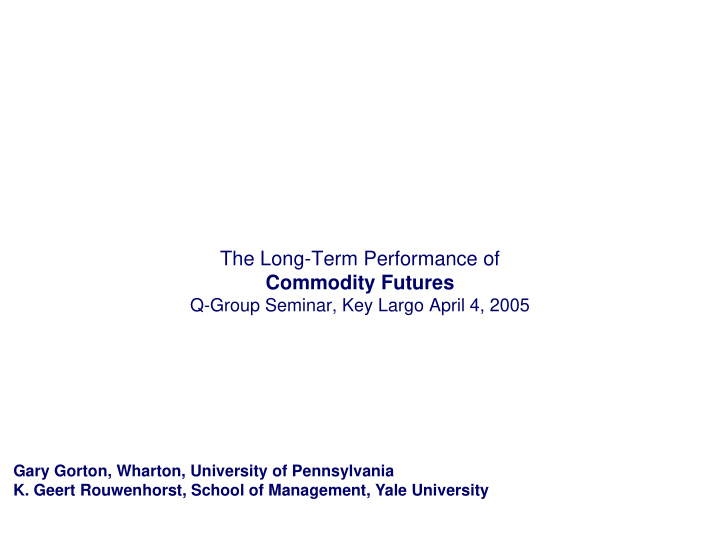



The Long-Term Performance of Commodity Futures Q-Group Seminar, Key Largo April 4, 2005 Gary Gorton, Wharton, University of Pennsylvania K. Geert Rouwenhorst, School of Management, Yale University
Futures Price vs. Expected Spot Price Inception (t) Expiration (T) Spot 30 Price(S t ) Spot & Market Futures Participants Expected Price Expect $3 Spot Spot Price Converge Price Fall at Expiry at Expiry E(S T ) S T = F T =27 27 27 Investors Expect $2 Risk Premium Futures 25 Price(F t ) 1
Collateralized Crude Oil Futures vs. Spot Prices Futures Up 87% While Spot Prices Decline 53% 2
Spot vs. Futures Returns Inflation Adjusted Performance From 1959 to 2004 3
Commodity Futures, Stocks and Bonds Inflation Adjusted Performance From 1959 to 2004 4
Risk Premium by Asset Class Annualized Monthly Excess Returns From 1959 to 2004 5
Risk and Return by Asset Class Annualized Monthly Returns From 1959 to 2004 6
Commodity Futures and Stocks Distribution of Monthly Returns From 1959 to 2004 7
Correlation of Commodity Futures With Other Financial Assets Overlapping Return Data From 1959 to 2004 8
Distribution of Monthly Equity Returns 9
Tail Distribution of Monthly Equity Returns 10
Correlation of Asset Classes With Inflation Overlapping Returns From 1959 to 2004 11
Correlation With Inflation Components Overlapping Returns From 1959 to 2004 12
Phases of the Business Cycle 13
Commodity Futures, Stocks and Bonds Average Returns by Business Cycle Stage From 1959 to 2004 14
Commodity Futures vs. Shares in Commodity Companies Inflation Adjusted Performance From 1962 to 2003 15
Summary Returns • The historical risk premium of commodity futures is comparable to the risk premium of stocks and exceeds the risk premium of bonds. • Stocks of commodity companies are a poor substitute for investments based on commodity futures. Risks • Commodity futures historically have been less risky than stocks, both in terms of volatility and downside risk. • Commodity futures historically have been negatively correlated with stocks and bonds. The negative correlation is stronger over longer holding periods. • Commodity futures have performed better in periods of inflation (especially unexpected inflation), when stock and bond returns have generally disappointed. • Commodities may diversify the cyclical variation in stock and bond returns. 16
Sensitivity of Equally-Weighted Commodity Indices to Rebalancing Assumptions Data From 1959 to 2004 17
Average Historical Returns to Individual Commodity Futures Data From 1959 to 2004 18
Average Historical Standard Deviation of Return to Individual Commodity Futures Data From 1959 to 2004 19
Average Historical Pair Wise Correlation of Individual Commodity Futures Data From 1959 to 2004 20
Cumulative Total Return of Commodity Futures Monthly Re-Sorted Portfolios According to Basis Data From 1959 to 2004 21
Monthly Excess Returns of Commodity Futures Portfolios Selected According to Futures Basis Monthly Data From 1959 to 2004 22
Recommend
More recommend